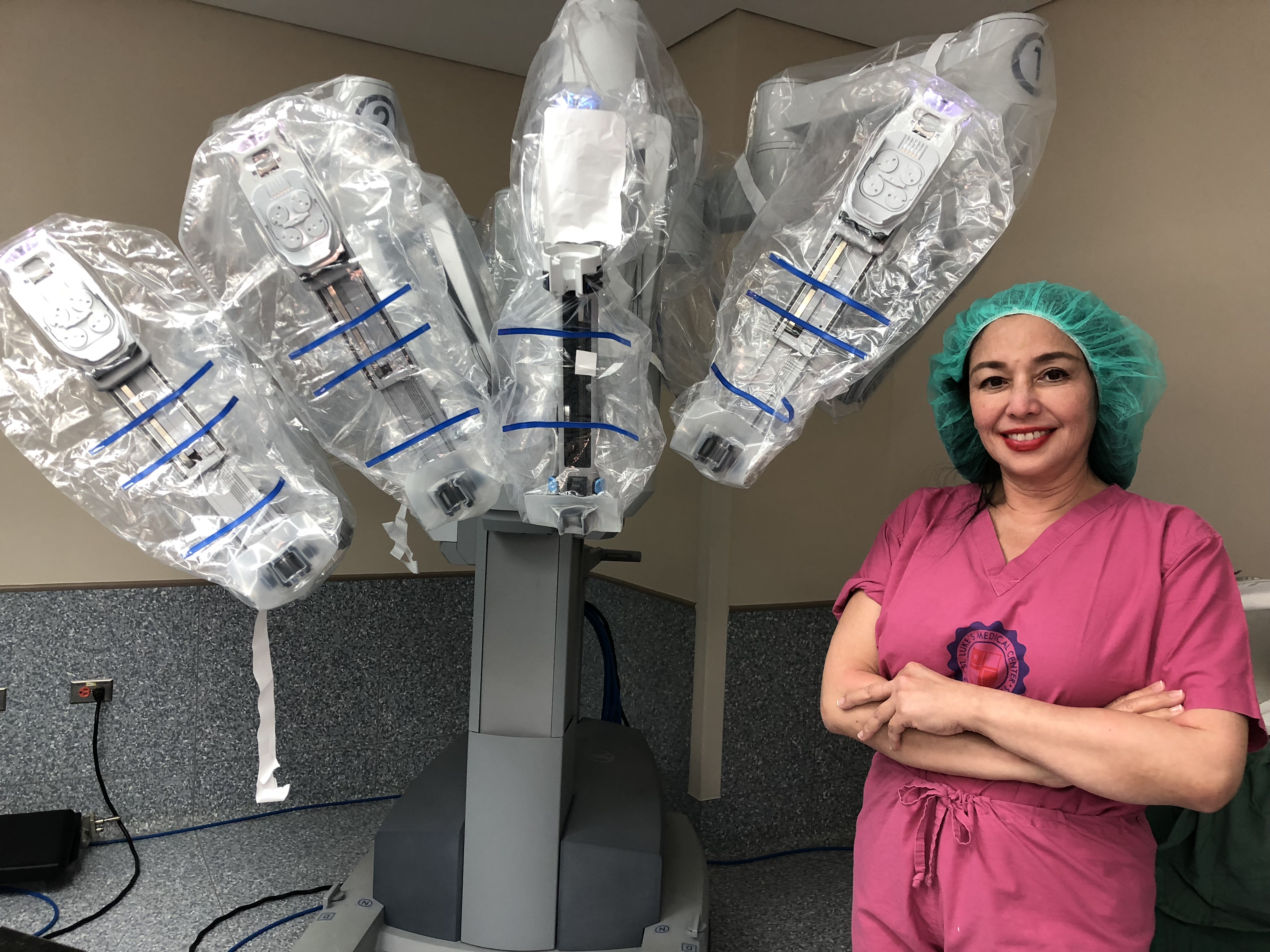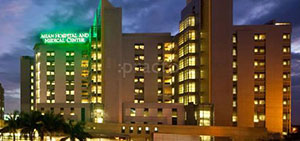Minimizing A Major Surgery
Bettina is a 33-year-old female, married 8 months ago, who came in to consult for fertility assistance. On routine ultrasound, she was found to have a 12 cm (the size of a small coconut) benign tumor in her uterus called myoma. Her gynecologist told her it had to be removed with an open surgery that would entail cutting her up with an incision far bigger than 12 cm to accommodate the removal of the mass. She felt faint and her hands grew clammy upon hearing this. She envisioned the pain, the loss of days of work and potential income because she was told her downtime would be around 6-8 weeks. She had never had surgery nor any pregnancy before so she felt an open surgery would be a defilement of her body, plus she would have to look at a huge scar all her life! She learned about the agony of her officemates who had undergone open surgeries for their myomas and ovarian cysts and it took them at least two months to recover and some still complain that every time it’s about to rain or the weather gets cold, their would hurts and bothers them.

She sought a second opinion with a different gynecologist who offered pretty much the same management. After googling and discovering minimally invasive surgery, she went for a third opinion. She then realized that majority of gynecologists are open surgeons and unless she sought the opinion of a certified Minimally Invasive Surgeon, an open surgeon usually would not offer her minimally invasive surgery since it was beyond their expertise. She then sought out a laparoscopic gynecologist who told her that the mass was too big to handle laparoscopically and offered her open surgery instead. So, she was back to square one.
Adamant to avoid an open surgery, she discovered that aside from Laparoscopic Surgery, there was even a more cutting edge form of Minimally Invasive technology called Robotic Surgery. There are only 126 certified Gynecologic Laparoscopic Surgeons by the Phil. Society of Gynecologic Endoscopy and of these, only 4 have leveled up to be internationally accredited Da Vinci Robotic Surgeons.
St Luke’s Global City is the only hospital in the Philippines with the Da Vinci SI Robot System. As of Jan 10, 2015, over 386 robotic surgeries have been accomplished to date and has the distinction of having a Gynecologic Robotics Program with the FASTEST GROWING number of Gynecologic Robotics surgeries to date. The complication rates are impressively low.
True enough, when Amanda sought the opinion of a robotic surgeon, robotic surgery was now offered to her as an option of treatment. She questioned why no one offered her robotic surgery as one of her options. Her sister pointed out to her that an open surgeon cannot give expert opinion about laparoscopic and robotic surgery nor could a laparoscopic surgeon give expert opinion about robotic surgery simply because they have no experience nor competence in the field. It dawned on her that this robotic surgeon performs laparoscopic and open surgery as well and could therefore offer her the best array of treatment options for her condition. And because of the unparalleled experience in the removal of huge myomas with the use of the robot, she concluded that this robotic surgeon and had the most competence to evaluate the best management for her huge tumor. True enough, her 12 cm myoma was removed successfully. After 48 hours, she was discharged from the hospital and was back to work in 7 days and travelled for work 10 days from surgery.

Dra. Rebecca Singson
There are many other applications for Robotic Surgery in the field of gynecology, aside from myomectomies such as: for removal of complex ovarian cysts, especially those beyond 8 cm, tubal reanastomosis to connect back tubes after tubal ligation, for hysterectomy (removal of the uterus) for benign or cancerous conditions, for repair of prolapsed vagina after a hysterectomy.
Robotic Surgery is a state of the art minimally invasive option for performing major surgeries with the use of the Da Vinci robot, a highly advanced robotic platform that can offer, and even surpass the precision, dexterity and competence of traditional open surgery with the use of incisions from 0.5-1.2 cm only. The Da Vinci Surgical System is a computer assisted surgery where the surgeon sits on a surgeon’s console, some distance away from the patient, while controlling 2-3 instruments inside the patient’s abdomen as well as a camera that can magnify the structures in the operative field 12-15 times bigger than the naked eye can see.
Compared to open surgery, robotic surgery results in reduced number of days of hospital stays, less blood loss and less blood transfusions. Because the incisions are tiny, there is significantly less postoperative pain, and therefore a reduced need for pain medications, less scarring, a reduction in post-operative adhesions, quick healing time and return to work and activities.

Compared to laparoscopic surgery, robot-assisted surgery gives the surgeon better control over the surgical instruments and a better view of the surgical site because of the 3-dimensional vision system, which gives the surgeon depth perception. Laparoscopic surgery involves the surgeon moving straight, non-rotating instruments directly inserted inside the patients abdomen while standing beside the patient. The operative field is viewed through a 2-dimensional flat screen monitor from a distance, negating depth perception. Movements of the surgeon are mirror image movements and are therefore counterintuitive, and take a long period of time and experience to get used to this opposite movement. In contrast, robotic surgery utilizes rotating instruments, which articulate even beyond what the human hand can do. The movements are intuitive because the instruments follow the surgeon’s hand movements. Importantly, the surgeon is seated comfortably in a surgeon’s console such that more complex surgeries can be accomplished with less fatigue on the part of the surgeon, as opposed to open or laparoscopic surgery. Furthermore, the hand tremors are filtered out by the robot’s software leading to greater precision.
| MINIMALLY INVASIVE SURGERY | OPEN SURGERY |
| Keyhole Band-Aid incisions | Long incisions |
| Magnification 10-12x higher than naked eye, therefore more precise dissection | No magnification |
| Less chances for infection with the small incision | More chances for infection due to big incision |
| Significantly less post-op pain | Much more painful |
| Less need for pain killers post-op | More drugs to address post-op pain |
| Less post-op adhesions | More post-op adhesions |
| Less blood loss | More blood loss |
| Shorter hospital stay | Longer hospital stay |
| Minimal to no scarring | Longer scars |
| ROBOTIC SURGERY | LAPAROSCOPIC SURGERY |
| Rotating instruments articulate beyond what the human hand can do | Straight instruments that don’t rotate |
| Instruments follow movements of the hand- intuitive | Instruments move opposite the movements of the hand – counterintuitive |
| 3-dimensional view of the operative field giving depth perception | 2-dimensional view only |
| Surgeon is seated comfortably on the surgeon’s console so less fatigue – ideal for complex procedures | Surgeon stands throughout the surgery so tiring for complex surgeries |
| Surgeon in full control of the camera plus 2-3 instruments with the use of the console | Surgeon can only control 2 instruments and is dependent on assist for other controls |
| Surgeon’s tremors are filtered out by robot | Tremors directly transmitted by the instruments |
Robotic surgery is a cutting edge technology that completely changes the paradigm of how surgery should be performed and what outcomes can be achieved. It is an enabling tool that can minimize the consequences of major surgery and can improve the lives of so many at a much shorter period of time.





